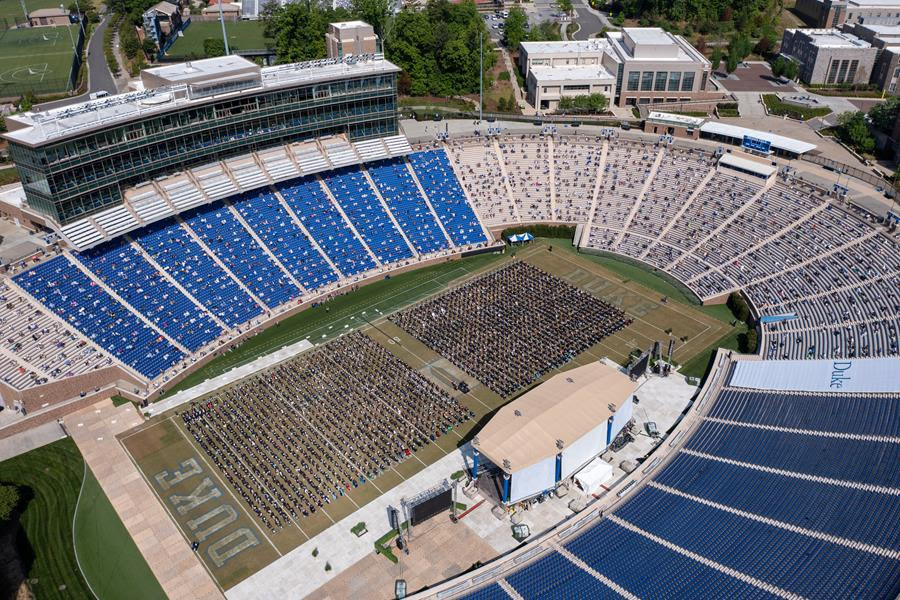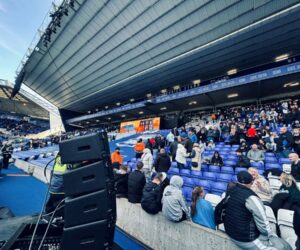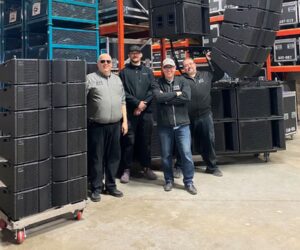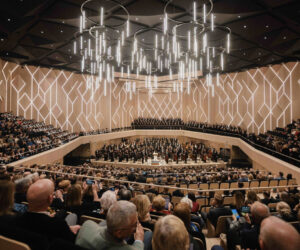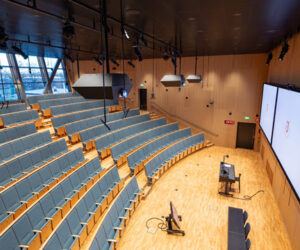Following cancellation last year due to the pandemic, graduates at Duke University in Durham, NC were able to enjoy an in-person ceremony, albeit one that was socially distanced, at Wallace Wade Stadium that was supported by sound reinforcement by RMB Audio (based in Selma, NC) utilizing Martin Audio MLA Compact joined by additional components from the company.
“We’ve serviced Duke University Commencement at the Wallace Wade Stadium [in Durham, N. Carolina] since the evolution of the campus back in 2003,” said the RMB Audio owner Cooper Cannady. “This year I was invited to initiate planning for an event which I knew may never occur.”
However, when University president Vincent Price finally received the green light from the U.S. Centers for Disease Control and North Carolina Department of Health and Human Services, the RMB Audio tech team had to function test all equipment that had been dormant for one year. The event was set for May 2; the stage loaded in on April 23 and the RMB Audio crew arrived on April 27. But the problem was that with strict socially distanced guidelines in force, the layout kept changing.

“Every day brought with it a new scenario,” states Cannady. While some 5,700 students had graduated, 2,000 undergraduates would attend, originally spaced 6 feet apart in the inner field (to engage them closely with the event), while the seating plans revised to allow an additional two guests. The 40,000-cap stadium would now host a total of 6,000 attendees, and the original 6-foot social distancing was reduced to 3 feet.
With the new seating design came a revision of the audio orientation. The planned seating at 180 degrees to the stage now increased to 220 degrees, placing seating behind the video wall. “We were tasked with improving the audience experience in a setting that was entirely new from what everyone had practiced for years,” Cannady explains. “Suddenly we were unable to accommodate a third house left MLA Compact tower and instead had to deploy a stealth Martin Audio W8VDQ, driven by iK42 amps, to cover the expanding audience.”
This was integrated and concealed at the base of the further house left tower, while the two hangs of 12 MLA Compact enclosures at stage right were accompanied by a single hang of 12 MLA Compact at stage left. Cannady: “Decorators were insistent that no cabinets could be within the main camera image that required Martin Audio DD12’s to be placed on stands at ground level corners of the stage to cover the canter first row of seats. The audio image was seamless.”

The changes had been necessitated by the fact that the additional guests were set behind the stage in a J-shape, without visual access to the stage, but instead to a large Jumbotron at the far end of the field, the I-MAG supported by two LED walls, stage left and stage right. Such a sparsely occupied stadium presented challenges for system tech, Matt Johnson, who notes, “It meant there were more reflections to deal with, although we generally have reflections off the seating in any case.” In Martin Audio’s proprietary DISPLAY 2.3 operating software, they were able to deploy the Hard Avoid function to mitigate these reflections.
Three identical lecterns were placed on stage, one of which was used by singer-songwriter John Legend, who delivered the commencement speech and also received an honorary degree. There was no live orchestra present this year — only a pre-recorded track — but there was a 7-piece a capella choral group spaced 4 feet apart.
“From the presenters’ perspective we set the monitor gain above the stadium reflections by having a monitor engineer listen from the stage participant position via a Neumann microphone to distinguish the monitor pulse and the SPL of the stadium reflections,” Johnson says.

Emphasizing the role played by MLA Compact, Cannady states, “We have used this system for the past three years and W8LM before that, in view of the weight restrictions.” RMB Audio had invested in MLA Compact back in 2012 when it first became available. “The reason we favor MLA Compact is because of the ability of the system to directly cover the audience in detail, and in sensitive situations such as this, these are the devices we prefer to use. In fact, it’s proven to be a fantastic device for us. Nothing can touch the technology that has gone into it … there is no other system that can take a slice out of the middle of an audience.”
RMB Audio staff on duty included Johnson joined by Roger Dennis, Wayne Sowder, Rick Null and Robert Weddings.


